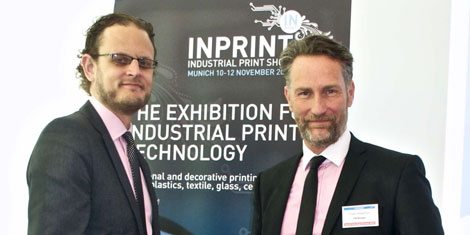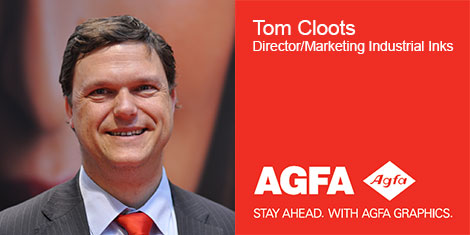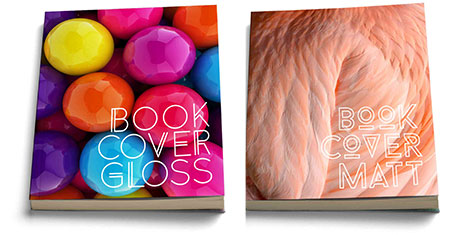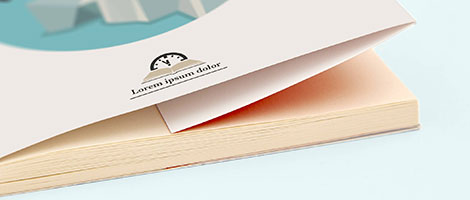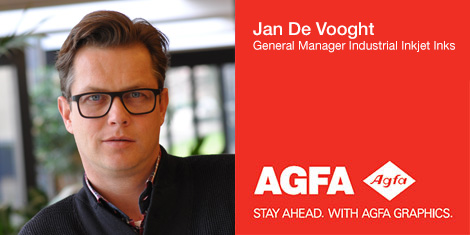
In the following blog, digital ink guru and General Manager Industrial Inkjet Inks at Agfa Graphics, Jan De Vooght, explains that ink, inkjet technology and ongoing ink developments are every bit as important, perhaps more so, than the latest all signing and all dancing hardware.
Go to any trade show and it is the inkjet printers that seem to take centre stage, gathering the largest crowds and the headlines. But although a great deal of attention is given to the mechanics and the output capabilities of the various inkjet engines, the ink technology itself rarely gets a mention.
However, it is not the hardware but rather the UV ink formulation that determines the suitability for each of the many applications of industrial printing.
Special ink formulations are indeed crucial for meeting the special requirements of most all industrial printing applications.
First of all the newest generations of print heads used in today’s inkjet engines require inks with excellent jettability and accurate dot placement. In particular compatibility with the newest print heads with speeds of up to and over 100m/min is required. This requirement calls for inks that feature high reactivity and ultra low viscosity capable of 4, 8 and 12 picolitre droplets.
With the increasing demand for industrial printing on various substrates such as plastics, metals, glass… all having different wetting properties, the ink formulations need to be tuned to the proper surface tension characteristics.
Industrial UV inkjet applications no longer print exclusively on flat surfaces. Inks are deposited directly on the product and are exposed to the same ambient conditions as the product itself during its entire lifetime. Chemical and abrasion resistance are therefore an absolute requirement. This can be achieved by the choice of unsaturated organic molecules, typically a mix of molecules with different degree of functionality. They form the bulk of the inkjet ink formulation, which after a sequence of radical polymerisation reactions will form a solid cross-linked network that determines specific physical properties of the cured ink layer, such as scratch resistance, solvent resistance, flexibility, and more.
In addition to this, pigments must be selected to have a good balance between colour gamut and outdoor resistance, e.g. for Sign & Display applications.
Perfect rendering of small print or fine details is equally becoming important for applications such as passport printing or the imprint of barcodes, QR codes or RFID tags.
Each of these requirements and many others are determined by the ink formulation and the design of inkjet inks has become a business on itself.
Built on experience
Agfa has a history of designing and developing high-tech consumables and components of inkjet printing, with focus on the interactions between these components, including the ink, the substrate, the piezo print head and the waveform of the piezo-electrical crystal, i.e. the sequence of electrical pulses that are applied to determine the drop size.
Agfa Graphics can also boast previous experience in applying functional liquids on various substrates, which gives us a leading edge over other ink manufacturers. Our R&D skills result in customised inks that can be formulated according to a list of technical specifications and with the purpose of fulfilling one of the following needs:
• Tuning of system-ink to the characteristics of (a) given inkjet device(s)
• Quality upgrade of an inkjet system through improved ink formulations
• Customised ink formulation for special (new) applications
With respect to the latter, Agfa Graphics has an extensive assortment of UV ink formulations that can be modified according to the specs for a given application – sometimes confined to certain conditions or requiring the ability to accommodate a wider variety of conditions. An example is the labeling industry: Next to general purpose UV inks which are designed for a broad range of label substrates (paper based and plastic based, as well as substrates primed, or pre-printed with flexo ink, or post-printed varnish), Agfa Graphics has also developed an UV ink set targeted specifically for paper based labels as well as another UV ink set targeted specifically for plastic based labels.
The industrial print applications can go pretty far. When Eartha, the world's largest revolving and rotating globe, was in need of restoration FedEx Office stepped in to give this landmark at DeLorme Headquarters, in Yarmouth, Maine (US) a facelift. With the Jeti 3020 Titan large-format printing technology, using UV inks on corrugated plastic, FedEx Office was able to reproduce the 792 map panels that comprise Eartha. Thanks to this creative use of industrial printing technology, visitors from around the globe will be able to admire this Guinness World Record attraction for years to come.
For more information on Agfa Graphics' involvement in the Eartha Globe restoration project, please visit: http://www.agfagraphics.com/gs/usa/en/internet/maings/products_solutions/customers_experience/fedex.jsp
Jan De Vooght




